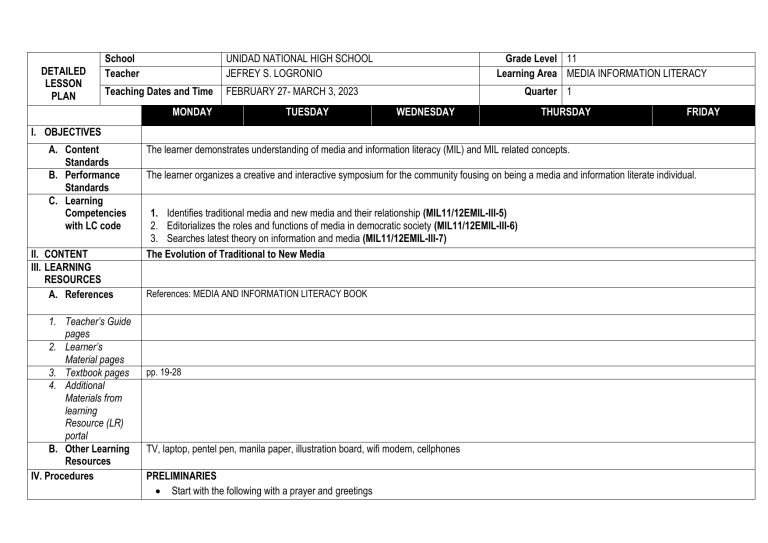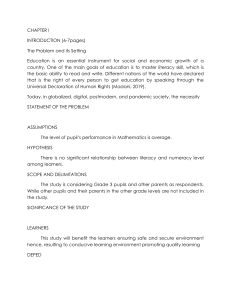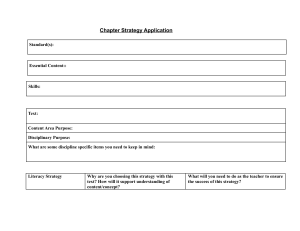
DETAILED LESSON PLAN School Teacher UNIDAD NATIONAL HIGH SCHOOL JEFREY S. LOGRONIO Teaching Dates and Time FEBRUARY 27- MARCH 3, 2023 MONDAY TUESDAY Grade Level 11 Learning Area MEDIA INFORMATION LITERACY Quarter 1 WEDNESDAY THURSDAY FRIDAY I. OBJECTIVES A. Content Standards B. Performance Standards C. Learning Competencies with LC code II. CONTENT III. LEARNING RESOURCES A. References 1. Teacher’s Guide pages 2. Learner’s Material pages 3. Textbook pages 4. Additional Materials from learning Resource (LR) portal B. Other Learning Resources IV. Procedures The learner demonstrates understanding of media and information literacy (MIL) and MIL related concepts. The learner organizes a creative and interactive symposium for the community fousing on being a media and information literate individual. 1. Identifies traditional media and new media and their relationship (MIL11/12EMIL-III-5) 2. Editorializes the roles and functions of media in democratic society (MIL11/12EMIL-III-6) 3. Searches latest theory on information and media (MIL11/12EMIL-III-7) The Evolution of Traditional to New Media References: MEDIA AND INFORMATION LITERACY BOOK pp. 19-28 TV, laptop, pentel pen, manila paper, illustration board, wifi modem, cellphones PRELIMINARIES Start with the following with a prayer and greetings A. Reviewing previous lesson or presenting the new lesson B. Establishing a purpose for the lesson C. Presenting examples/ Instances of the new lesson Checking of attendance Setting the mood, and classroom standards Review the previous activities and outputs of learners Present the objective Present the objective by by allowing learners allowing learners to read to read the the objectives. objectives. Direction: Students will interact to their teacher about their idea on the topic. Presentation of summary of students’ outputs Review the previous discussions on festival dances. Present the objective by allowing learners to read the objectives. Direction: Discuss the five (5) functions of communication and media. Video Watching: Direction: Students will watch the History of Communication video D. Discussing new concepts and practicing new skills #1 E. Continuation of discussion of new concepts leading to formative assessment F. Developing Mastery (Leads to formative Assessment 3) - What is the difference between traditional media and new media? Lecture: - Discuss the approach of traditional media vs. new media. Video Watching: Students will watch the three videos: - History of Social For each point: - What symbolisms are used in this illustration? - What is the message of the illustration? Review the previous discussions on festival dances. Present the objective by allowing learners to read the objectives Present short directions about the day’s activity - - G. Finding practical applications of concepts and skills in daily living Media How Has Technology Changed Us?: The Medium is the Message World Press Freedom Day 2017: UNESCO calls for better protection of press - Do you agree with the message? Why or why not? Class recitation activity: A. “The Medium is the Message” 1. Explain the statement of Marshall McLuhan that “The Medium is the Message”. 2. Does technology shaped us or is it us who shaped technology? Explain your answer and give an example. Recitation: What issues facing journalist are mentioned in the news? The students will be graded based on the accuracy of their answers during the class recitation. B. News Report 1. What is the news all about? 2. What issues facing journalist are mentioned in the news? a. Making generalizations and abstraction about the lesson - Relate these points into the current issues of Philippine Media - Analysis: Discuss on the issue of media in the Activity: Political cartoon drawing Instructions: Group of 3 students 1. Draw on a short bond paper a political cartoon depicting your opinion about how the Philippine media performs its roles and functions in the Philippines which is a democratic country. (10 Philippines a. Media Killings b. “Unfair, Twisted Coverage” comments by President Rodrigo Duterte. points) 2. Explain the message of your political cartoon in not less than 3 sentences. (5 points) b. Evaluating learning c. Additional Activities for application or remediation V. REMARKS VI. REFLECTION Research on the current issues of media in the Philippines. A. No. of learners who earned 80% in the evaluation. B. No. of learners who require additional activities for remediation C. Did the remedial lessons work? No. of learners who have caught up with the lessons. D. No. Learners who continue to require remediation E. Which of my teaching strategies worked well? Why did this work? F. What difficulties did I encounter which my principal or supervisor can help me solve? G. What innovation or localized materials did I used/discover which I wish to share with other teachers? Prepared by: JEFREY S. LOGRONIO Subject Teacher Checked by: NOEMI AIREEN M. ABRAHAM Principal II Give quiz about the lessons discussed and presented. DETAILED LESSON PLAN School Teacher UNIDAD NATIONAL HIGH SCHOOL JEFREY S. LOGRONIO Teaching Dates and Time MARCH 6 -10, 2023 MONDAY VII. TUESDAY Grade Level 11 Learning Area MEDIA INFORMATION LITERACY Quarter 1 WEDNESDAY THURSDAY FRIDAY OBJECTIVES D. Content Standards E. Performance Standards F. Learning Competencies with LC code VIII. CONTENT IX. LEARNING RESOURCES C. References 5. Teacher’s Guide pages 6. Learner’s Material pages 7. Textbook pages 8. Additional Materials from learning Resource (LR) portal D. Other Learning Resources X. Procedures The learner demonstrates understanding of media and information literacy (MIL) and MIL related concepts. The learner organizes a creative and interactive symposium for the community fousing on being a media and information literate individual. 1. defines information needs, locates, accesses, assesses, organizes, and communicates information (MIL11/12EMIL-IIIc-8) 2. locate, access, assess, organize and communicate information (MIL11/12EMIL-IIIc-8) 3. demonstrate ethical use of information.(MIL11/12EMIL-IIIc-9) Information Literacy References: MEDIA AND INFORMATION LITERACY BOOK pp. 29-36 TV, laptop, pentel pen, manila paper, illustration board, wifi modem, cellphones PRELIMINARIES Start with the following with a prayer and greetings Checking of attendance Setting the mood, and classroom standards H. Reviewing previous lesson or presenting the new lesson I. Establishing a purpose for the lesson J. Presenting examples/ Instances of the new lesson Review the previous activities and outputs of learners Present the objective Present the objective by by allowing learners allowing learners to read to read the the objectives. objectives. Direction: Students will interact to their teacher about their idea on the topic. Direction: Students will be watching videos about Information Literacy & 21st Century Literacy. K. Discussing new concepts and practicing new skills #1 L. Continuation of discussion of new concepts leading to formative assessment M. Developing Mastery (Leads to formative Assessment 3) - What determines your need for information? Guide question: - How will they relate the video? - Why is information literacy important when processing thoughts or facts? Discussion: - Definition of Information Literacy - Components of Information Literacy - Guide questions: What are the five components of information literacy? Review the previous activities and outputs of learners Present the objective by allowing learners to read the objectives. Direction: Discuss the five (5) functions of communication and media. Review the previous activities and outputs of learners Present the objective by allowing learners to read the objectives Present short directions about the day’s activity Explain each component by relating it to your experience in doing research (relate to concepts in Practical Research course). N. Finding practical “Audio Visual Presentation” applications of concepts and skills in The class will be divided daily living into groups with 3 members. Each group will create an audio - visual presentation (Text, Pictures, and Audio) about what information literacy is and why information literacy skills are important. d. Making generalizations and abstraction about the lesson e. Evaluating learning - Definition of Information Literacy Soundtrack or music must be in minus one (instrumental). Although minus one, the music must not be associated with cursing, vulgar words, or profanity. Give quiz about the lessons discussed and presented. f. Additional Activities for application or remediation Create the audio-visual presentation. Students can use any computer software, web tools, or mobile application for making an audio-visual presentation. (e.g. Windows Movie Maker, iMovie, Animoto, VideoShow, etc.) XI. REMARKS XII. REFLECTION H. No. of learners who earned 80% in the evaluation. I. No. of learners who require additional activities for remediation J. Did the remedial lessons work? No. of learners who have caught up with the lessons. K. No. Learners who continue to require remediation L. Which of my teaching strategies worked well? Why did this work? M. What difficulties did I encounter which my principal or supervisor can help me solve? N. What innovation or localized materials did I used/discover which I wish to share with other teachers? Prepared by: JEFREY S. LOGRONIO Subject Teacher Checked by: NOEMI AIREEN M. ABRAHAM Principal II DETAILED LESSON PLAN School Teacher UNIDAD NATIONAL HIGH SCHOOL JEFREY S. LOGRONIO Teaching Dates and Time MARCH 13 -17, 2023 MONDAY XIII. TUESDAY Grade Level 11 Learning Area MEDIA INFORMATION LITERACY Quarter 1 WEDNESDAY THURSDAY FRIDAY OBJECTIVES G. Content Standards H. Performance Standards I. Learning Competencies with LC code XIV. CONTENT XV. LEARNING RESOURCES E. References 9. Teacher’s Guide pages 10. Learner’s Material pages 11. Textbook pages 12. Additional Materials from learning Resource (LR) portal F. Other Learning Resources XVI. Procedures The learner demonstrates understanding of media and information literacy (MIL) and MIL related concepts. The learner organizes a creative and interactive symposium for the community focusing on being a media and information literate individual. 1. Classify contents of different media types (MIL11/12EMIL-IIId-10) 2. Defines media convergence through current examples (MIL11/12EMIL-IIId-11) 3. Discusses to class on how a particular individual or society is portrayed in public using different type of media(MIL11/12EMIL-IIId-12) Types of Media References: MEDIA AND INFORMATION LITERACY BOOK pp. 37-46 TV, laptop, pentel pen, manila paper, illustration board, wifi modem, cellphones PRELIMINARIES Start with the following with a prayer and greetings Checking of attendance Setting the mood, and classroom standards O. Reviewing previous lesson or presenting the new lesson P. Establishing a Explain to the students that purpose for the lesson the purpose of this lesson is to explore different types of media and their characteristics, as well as their impact on society and individuals. Q. Presenting examples/ Present examples of Instances of the new different types of media, lesson such as television, radio, newspapers, magazines, social media, and others. Review the previous activities and outputs of learners Explain to the students that the purpose of this lesson is to explore different types of media and their characteristics, as well as their impact on society and individuals. Present examples of different types of media, such as television, radio, newspapers, magazines, social media, and others. R. Discussing new concepts and practicing new skills #1 Define media and its role in society. Discuss the characteristics of different types of media, such as the target audience, purpose, format, and frequency of delivery. Discuss the advantages and disadvantages of each type of media and their impact on individuals and society. Engage students in group discussions and activities to practice identifying the different types of media and their characteristics. Review the previous activities and outputs of learners Review the previous activities and outputs of learners Explain to the students that the purpose of this lesson is to explore different types of media and their characteristics, as well as their impact on society and individuals. Present examples of different types of media, such as television, radio, newspapers, magazines, social media, and others. Define media and its role in society. Discuss the characteristics of different types of media, such as the target audience, purpose, format, and frequency of delivery. Discuss the advantages and disadvantages of each type of media and their impact on individuals and society. Engage students in group discussions and activities to practice identifying the different types of media and their characteristics. S. Continuation of discussion of new concepts leading to formative assessment Conduct a class discussion on the impact of media on individuals and society, such as the influence on opinions, beliefs, and behavior. Provide real-life examples of media's impact, both positive and negative, and encourage students to share their opinions and experiences. Give students a formative assessment to check their understanding of the different types of media and their characteristics. T. Developing Mastery (Leads to formative Assessment 3) U. Finding practical applications of concepts and skills in daily living g. Making generalizations and abstraction about the lesson Conduct a class discussion on the impact of media on individuals and society, such as the influence on opinions, beliefs, and behavior. Provide real-life examples of media's impact, both positive and negative, and encourage students to share their opinions and experiences. Give students a formative assessment to check their understanding of the different types of media and their characteristics. Provide additional practice activities to reinforce the concepts learned, such as identifying and analyzing different media examples. Conduct a group project or presentation where students can demonstrate their understanding of the types of media and their impact on society and individuals. Conduct a formative assessment to check students' mastery of the concepts learned. Discuss with students how the concepts learned can be applied to real-life situations, such as media literacy, critical thinking, and responsible media consumption. h. Evaluating learning i. Have students reflect on their learning by evaluating their understanding of the concepts and skills learned in the lesson. Additional Activities for application or remediation XVII. XVIII. Provide additional activities for students who may need further practice or remediation, such as online resources or independent projects. REMARKS REFLECTION O. No. of learners who earned 80% in the evaluation. P. No. of learners who require additional activities for remediation Q. Did the remedial lessons work? No. of learners who have caught up with the lessons. R. No. Learners who continue to require remediation S. Which of my teaching strategies worked well? Why did this work? T. What difficulties did I encounter which my principal or supervisor can help me solve? U. What innovation or localized materials did I used/discover which I wish to share with other teachers? Prepared by: JEFREY S. LOGRONIO Subject Teacher Checked by: NOEMI AIREEN M. ABRAHAM Principal II Give quiz about the lessons discussed and presented.

